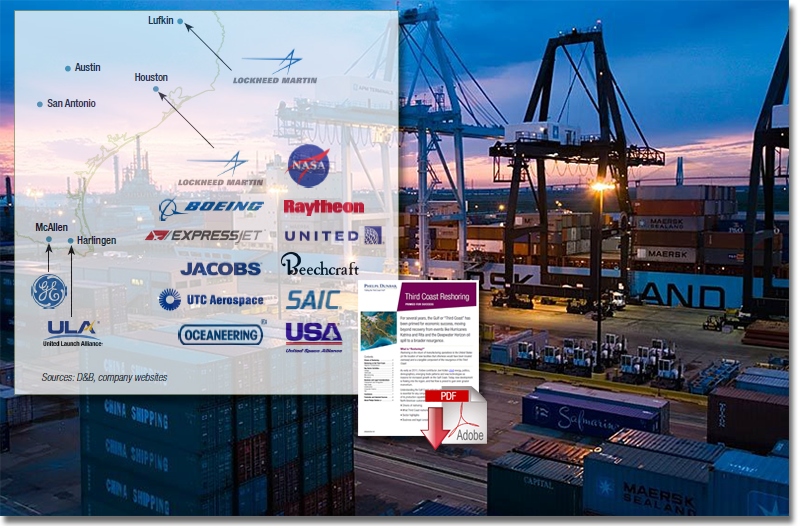“The Third Coast” Port of Houston Primed for Success

While the West Coast struggles with congestion and dysfunctional politics, the Third Coast - the urbanized, broadly coastal region spanning the Gulf from Brownsville, Texas, to greater Tampa - is emerging as a center of industry, innovation, and economic growth.
As one might expect, The Third Annual Global Supply Chain Excellence Summit staged by the USC Marshal School of Business last week placed a major focus on Southern California ports.
Critical congestion issues were addressed, as was the fact that both Long Beach and Los Angeles face increasing competition from ports in Canada and Mexico for “mega-ship” market share.
But another deep-water U.S. ocean cargo gateway was also given a platform to speak at USC: The Port of Houston.
“When shippers think about the Gulf, it’s usually in terms of energy-related bulk and breakbulk goods, says John Moseley, senior director, trade development for the Port of Houston. “But our volumes have increased steadily since the congestion crisis hit the West Coast, and we are building the infrastructure to attract even more container traffic.”
Indeed, business at the Port of Houston Authority terminals continues at a record pace, and Mosely says a surge in inbound twenty-foot equivalent units (TEUs) was a key performance driver.
Year to date through June, the Port Authority’s Barbours Cut and Bayport Container Terminals showed a 20 percent increase in loaded container units. The general cargo terminals showed a robust 26 percent growth in import steel tonnage during this same period.
Mosely reports that the Port Authority successfully assumed full operations of the Maersk terminal this summer and now has the capacity to operate the entire terminal property and can distribute box volumes more evenly between its two container handling facilities.
The result will be better service to trucks through common gates, more flexibility to ocean carriers and greater efficiencies in the container yards. Maersk Line, and its affiliated shipping services, SeaLand and Safmarine, will continue to call at the Port of Houston Authority terminals as common carriers.
Third Coast Reshoring

For several years, the Gulf or “Third Coast” has been primed for economic success, moving beyond recovery from events like Hurricanes Katrina and Rita and the Deepwater Horizon oil spill to a broader resurgence.
Photography: Jake Wyman
Download the Paper: Third Coast Reshoring
Furthermore, points out Mosely, Frontier Logistics completed their option period and committed to move forward on the development of an approximately 55 acre rail-served warehouse adjacent to the Barbours Cut Terminal. The initial phase is expected to be completed in 2017 and will include a resin packaging warehouse with products that can be shipped through Barbours Cut and Bayport Terminals.
“Diversification of cargoes has helped Houston enormously,” says Mosely, “and the diverted ocean carrier calls from Southern California was an added bonus this year. But it’s important to note that 60 percent of growth was ‘organic,’ and therefore more sustainable. We are ranked as the sixth largest box port in the nation, and we expect to move up that chart next year.”
Many prominent consultants and analyst think so too. According to economist John C. Martin, Ph.D., president of Lancaster, Pa.-based Martin Associates, Houston’s investment in infrastructure will pay off as more vessel operators look for alternatives to West Coast calls.
“It’s hard to over-emphasize the value of this investment, particularly when you factor in how much it helps lower the cost of imports and make our exports more competitive overseas,” he says.
At the same time, Jonathan Rosenthal, chief executive officer and managing partner of the investment firm, Saybrook Capital, maintains that the LA/LB may not be keeping pace.
“In my business, we follow the money, and we see that the port ecosystem here is a little bit broken,” he says.
Other pressures undermining U.S. West Coast dominance is the geographical advantage of what is being called “The Third Coast.”
Joel Kotkin, a distinguished presidential fellow in urban futures at Chapman University in Orange, California, and an adjunct fellow with the Legatum Institute based in London, UK., coined the expression (“The Third Coast”) in a body of research he completed recently for the Praxis Strategy Group, an economic development consultancy.
Related Read: The Rise of the Third Coast
“There is a dramatic geographic shift toward this area,” he says. “The country’s next great megacity, Houston, is here; so is a resurgent New Orleans, as well as other growing port cities that serve as gateways to Latin America and beyond,”
Kotkin adds that while the West Coast struggles with congestion and dysfunctional politics, the Third Coast - the urbanized, broadly coastal region spanning the Gulf from Brownsville, Texas, to greater Tampa - is emerging as a center of industry, innovation, and economic growth.
The trends favoring the Third Coast will accelerate further once the Panama Canal expansion is completed next year, concludes Kotkin, as mega vessels will no longer be held captive to deep water ports on the U.S. Pacific Rim.
Nick Vyas, director, USC Marshall Center for Global Supply Chain Management, allows that the ports in Southern California have “latent capacity,” and the executive directors form both Los Angeles and Long Beach echo that sentiment.
But for many of us attending the Excellence Summit, the question remains: Will infrastructure development be too little/too late for San Pedro Bay ports when it comes to facing down this new threat?
Related: Top 20 U.S. Ports: Competition Heats-Up for Discretionary Cargo

Article Topics
University of Southern California News & Resources
Amazon’s U.S. Logistics Footprint is Expanding U.S. Dept. of Commerce Partners with USC Marshall Center to Advance Nation’s Supply Chain Amazon Creating 120,000 Seasonal Jobs in Fulfillment and Customer Service Warehouse Work: Path to the Middle Class or Road to Economic Insecurity? Third Coast Reshoring “The Third Coast” Port of Houston Primed for Success The Use of Social Media in the Supply Chain: Survey and Extensions More University of Southern CaliforniaLatest in Transportation
Talking Supply Chain: Doomsday never arrives for Baltimore bridge collapse impacts Amazon Logistics’ Growth Shakes Up Shipping Industry in 2023 Nissan Channels Tesla With Its Latest Manufacturing Process Why are Diesel Prices Climbing Back Over $4 a Gallon? Luxury Car Brands in Limbo After Chinese Company Violates Labor Laws The Three Biggest Challenges Facing Shippers and Carriers in 2024 Supply Chain Stability Index: “Tremendous Improvement” in 2023 More TransportationAbout the Author















